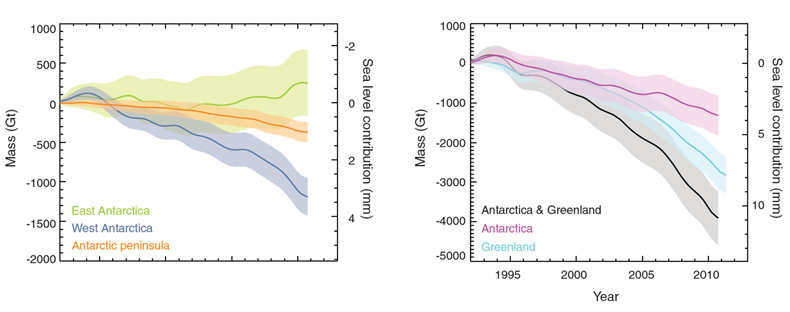The results of the IMBIE 2012 experiments showed that the agreement between mass balance estimates from radar and laser altimetry, gravimetry and the input-output method is good in all ice sheet regions.
In combining the datasets we generated a 19 year time series of ice sheet mass balance from 1992 to 2011. Over this period, we found that the Greenland and Antarctic Ice Sheets together lost mass that equated to a global rise in sea level of 11.1 +/- 3.8 millimetres.
Examining the ice sheet regions individually we show that the Greenland, West Antarctic and Antarctic ice sheets have all lost mass over the past two decades, whilst the East Antarctic ice sheet has undergone a slight snowfall-driven growth. The Greenland ice sheet has lost the largest mass and accounts for about two-thirds of the combined ice sheet loss over the study period. In Antarctica, the largest mass losses have occurred in the West Antarctic Ice Sheet. However, despite occupying just 4% of the total ice sheet area, the Antarctic Peninsula has accounted for around 25% of the Antarctic mass losses.
We created charts of mass change (see figure below) for each geographical region, and these confirm known signals of imbalance. Mass loss from the Greenland, West Antarctic and Antarctic Peninsula Ice Sheets has increase over time. In Greenland, rates of mass loss were modest during the 1990’s but have sharply accelerated since then due to episodes of ice acceleration (Rignot and Kanagaratnam, 2006; Joughin et al.,2004) and decreased surface mass balance (van den Broeke et al.,2009; Ettema et al., 2009). The rate of mass loss from the West Antarctic Ice Sheet increased substantially over the study period, with losses occurring mainly due to glacier acceleration in the Amundsen Sea Sector. The Antarctic Peninsula Ice Sheet was close to balance in the 1990’s, but since then significant mass losses have occurred as a result of ice shelf collapse (Rott et al., 1996;De Angelis and Skvarca, 2003) and calving front retreat (Cook et al., 2005; Pritchard et al.,2009). Overall our time series of mass change show that the combined losses from Greenland and Antarctica have increased over time and the ice sheets are now losing almost three times as much ice as they were in the early 1990’s.
Time series of cumulative mass change and sea level contributions from the East, West and Antarctic Peninsula ice sheets (left), and Antarctic, Greenland, and combined Antarctic and Greenland ice sheets (right).



